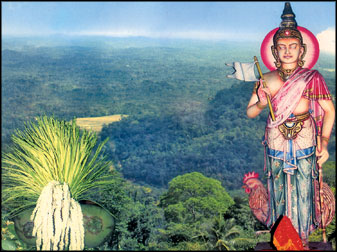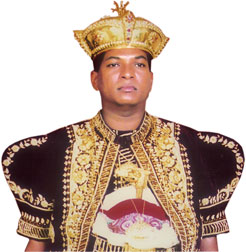Esala Perahara at the historic Sittamgallena Maha Viharaya
The annual Esala Maha Randoli Perahera at the historic Sittamgallena
Raja Maha Viharaya will be held Thursday 26. The Viharaya which is
popularly known as Rajjuru Bandara Devalaya in the area is consecrated
to the local deity Rajjuru Bandara Deiyo. In the annals of Ruhuna, the
cult of Sittamgallena Rajjuru Bandara Deiyo who is only second to God
Skanda or kumara Kataragama Deiyo, is traditionally held in high
veneration by the Ruhuna people. They naturally invoke his blessings for
a bountiful paddy harvest and other subsidiary food-crops such as
cowpea, maize, meneri and kitul treacle industry as well. The historic
Perahera was first launched in 1968 to pay homage to Rajjuru Bandara
Deiyo when one local resident received a "devine message" that a
Perahera headed by an elephant should be held to propitiate Rajjuru
Bandara Deiyo. The Perahera which had a humble beginning is held today
with all pomp and pageantry. Presumably the Viharaya would have been
decorated with murals and hence the name, Sittamgallena Viharaya which
means - cave of murals.
 |
|
Rajjuru Bandara Deiyo |
Kolmura Yagaya, a special feature of the Esala festival is held to
pay tribute to Rajjuru Bandara Deiyo and Goddess Pattini and invoke
their blessings for a prosperous harvest.
The Perahera is concluded with the devotees being served with a
breakfast which consists of rice and ash plantain "malluma" and the
water-cutting ceremony held at Warapitiya Wewa.
'Gira-Pattuwa', the area abundant in parrots was renamed
Giruwapattuwa according to the Britisher, Vincent Legg who researched on
birds as early as 1883. Birds apart, the nature has gifted the
unsophisticated villagers in Giruwapattuwa with an adequate water
resource so that their life-line, the agriculture could thrive.
With the construction of the Urubokka anicut in 1826 by William
Gisbon, water was channelled to feed Rajapaksa Reservoir at Muruthawela
and finally the Udukiriwila reservoir which enabled recultivating
thousands of fallow fields in Katuwana, Medamulana and Weeraketiya.
Storing water in Muruthawela reservoir to feed the thirsty lands in
Katuwana, Kirama, Bookendayaya, Medamulana, Middeniya, Gonadeniya and
Walasmulla for a bountiful harvest was D.A. Rajapaksa's brain-child. The
peasantry in the Rammal range lived a simple, healthy life with no
pretensions for the unattainable! Basically paddy and chena cultivation,
kithul treacle, jak and bread fruit provided the means of their
subsistence.
Villages such as Katuwana, Gomadiya and Siyarapitiya still retain
with them attributes of peasant life bringing pride to the country. The
bullock cart which continues to be a mode of transporting village
produce to the local fair, is surely a novel experience for the more
sophisticated urban dweller!
 |
|
Basnayake Nilame
Kithsiri Abeygunawardena |
That Katuwana and Kirama villages had produced local gun-smiths and
some of their makes were in use until recently, is borne out by the
colonial era Assistant Government Agent Granvil William's famous report
on Matara-Hambantota made as early as 1813. Recent archaeological finds
have unearthed evidence of the art of melting iron for turning out
tools. Coupled with such local expertise is the indigenous technology
utilised to make citrus and cinnamon oil.
Architecture varies from its primitive form to Gothic style. Pestle
and mortar, grinding stone, barn and attic continues to be the last
vestiges of a by-gone era. The Katuwana old Dutch Fort, a two-storeyed
structure has weathered all vagaries of nature in its fight to maintain
its identity up to date.
The legacy of Giruwapattuwa was strongly felt in the highest
legislature of the country with the election of Mahinda Rajapaksa, a
true son of Magama as onetime member of Parliament, Minister, Leader of
Opposition, Prime Minister and finally the Executive President of the
country who as Commander-in-Chief marshalled his Security Forces and
annihilated the most brutal terrorist organisation and made Sri Lanka a
land of peace and tranquillity for all peace and freedom loving people.
(Translated by K.D.M. Kittampahuwa.)
|

